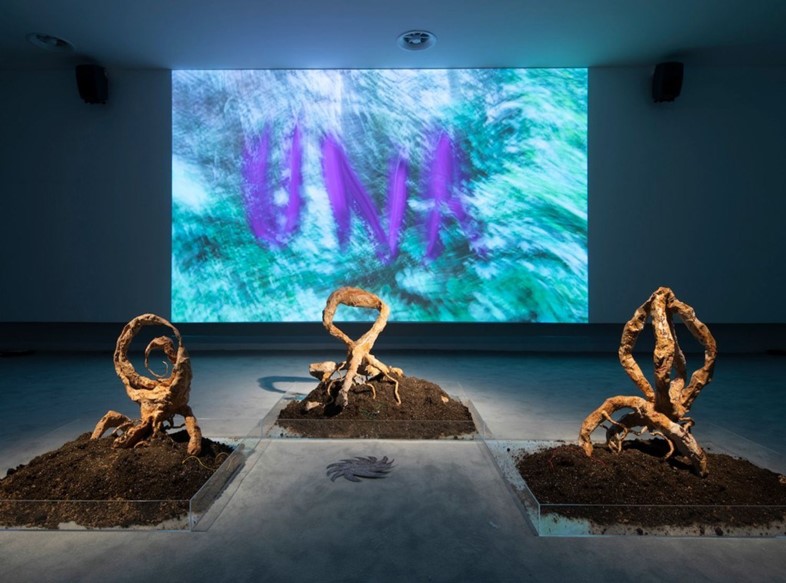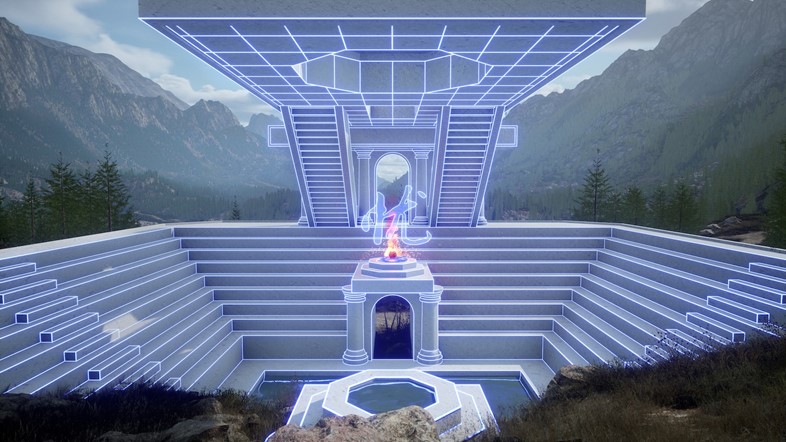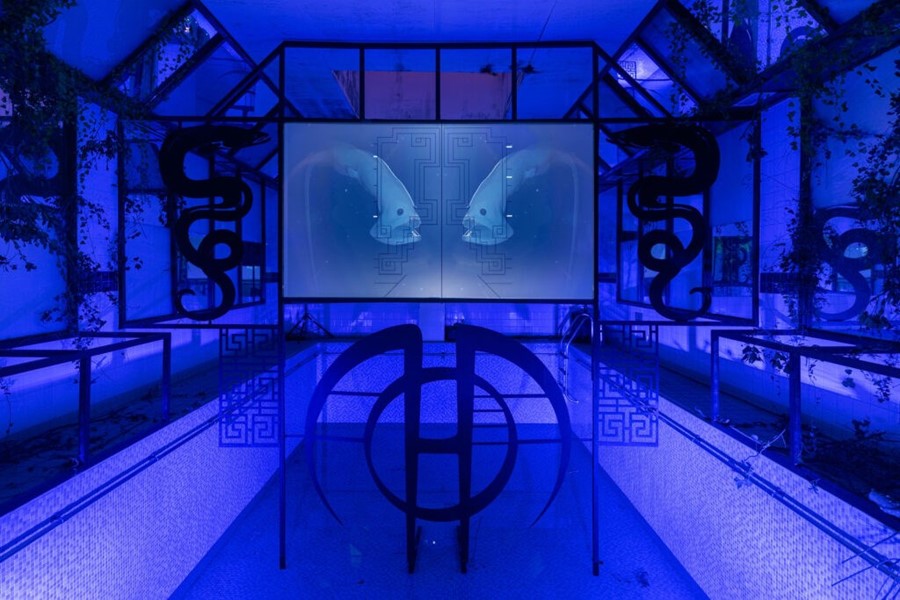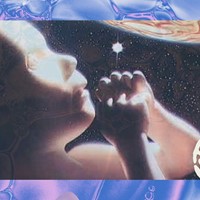New Worlds, a series of talks, screenings and performances at Somerset House Studios, explores the relationship between technology and mysticism through rituals, myth-making, and more-than-human narratives
Ever since humans first carved words into stone, the relationship between man and technology has been imbued with magic. As a tool, technology has been used to spread information from the very beginning, with legends, proverbs and jokes feeding into the creation of a shared body of culture that isn't too dissimilar from the collective narratives available online today in the form of social media and memes. Yet the western world’s emphasis on post-Enlightenment ideas of science, technology, and individual liberties has created a wedge between myth and machine. Anthropocenic ideas dominate the datastream and tell us that nature should be conquered to benefit humans. Even though we now know that’s not the case (see: climate catastrophe, microplastics, shrinking penises), we’re stuck in a capitalist headlock that pushes profit above all else.
But the relationship between technology and spirituality is closer than you might think. There’s more to machines than cold, computerised networks, just as there’s more to humans than bodies and brains. It’s the mythology that exists within these systems, through stories and communication, that breathes life into the anthropological matrix. These stories can be used to dislodge our human-first approach to society – for example, urbanisation, deforestation, pollution – so that we can use technology in a way that works for, not against, nature. “This way of thinking and existing with other species, in between realms, is not new; it underpins many ancient cosmologies and indigenous schools of thought. I think these practices can help dislodge the human-centric idea of the anthropocene, to focus on building a viable future for more than one species,” says Alice Bucknell, the founder of New Mystics, a digital platform merging magic and technology.
New Worlds, Bucknell’s latest series of talks, screenings and performances at Somerset House Studios, builds on this research. Featuring artists such as Lawrence Lek, Evan Ifekoya, Bones Tan Jones, Joey Holder and OMSK Social Club, the series explores the interconnected topics of sound and ritual, myth-making, non-linear storytelling, ecological futures, and more-than-human narratives. “I think of mysticism as a kind of technology – a capacity to commune with the unknown, a means of dilating and entangling our understanding of the world through altered states of consciousness,” says Bucknell.
Technology, Bucknell says, has always been entangled with a sense of the mystical. “As it grows increasingly more advanced, we liken it to a kind of oracle or deity in its own right,” she says. Nowadays, it’s hard to know where technology ends and the mind starts, as everyday objects such as a phone or laptop are seen as physical extensions of our inner selves. Online, we instil tech with a sense of animism, attaching all kinds of sounds, meaning and information to what we see. This can be virtual glyphs in the shape of memes, or recognising that a DM represents not just a bundle of code, but its own set of signs and signifiers.

“The conventional view is that technology is the antithesis of mysticism,” says Lawrence Lek, who is based in London. “The growth of science and technology is often seen as the human quest for knowledge or mastery of nature, as the need for belief systems like magic or religion generally decreases with ‘progress’ in science.” As tech grows more advanced through breakthroughs in artificial intelligence, however, the relationship between magic and technology becomes further entangled. As sci-fi writer Arthur C Clarke says in his book Profiles of the Future, “Any sufficiently advanced technology is indistinguishable from magic.”
Though plugged into nature’s switchboard, our physical experience is consistently exchanged for the virtual reality of disembodied networks and computer screens. We don’t understand how technology works, how the algorithm directs our interests and artificial intelligence morphs our understanding of reality. “There are so many things that are beyond the limitations of human knowledge and understanding, so we call them magical or supernatural. Computation appears to be like magic because it’s very difficult for us as individuals to understand its operations,” explains Joey Holder, whose practice encompasses myth-building and speculative futures . “Algorithmic processes are black boxes, hidden from everyday life, but which occur everywhere in the background.”
“Technology and mysticism are yin and yang. Technology, in terms of new digital technologies, are just accelerations of ancient technologies our ancestors used or strived for” – Bones Tan Jones
Even the earliest markers of modern technology have their roots in spiritualism. For example, the ancient Chinese philosophical text known as The I-Ching was the main inspiration behind the binary code used today in almost every computer. “Technology and mysticism are yin and yang. Technology, in terms of new digital technologies, are just accelerations of ancient technologies our ancestors used or strived for,” says Bones Tan Jones, who explores the relationship between the internet and new age hypocrisy in their work. Similarly, the progenitors of today’s global digital culture started out in the hippy communes of 60s and 70s California, with figures like Steve Jobs and Steve Wozniak advocating for an idea of personal freedom that would later morph into the techno-utopianism of Silicon Valley.
“I think technology can reveal or open up certain portals, new ways of thinking, when it's approached symbiotically – neither an all-consuming power nor something entirely human-made and human-serving,” says Bucknell. “Within contemporary art, the recent and ongoing interest in nonhuman narratives and non-linear understandings of time has led to an exciting proliferation of practices that resist the techno-heroic, time-killing-arrow of capitalism, which has led to the false binary of human and nonhuman, the closure of interconnected systems and means of living with the world, and the destruction of the Earth in the name of (human) profit.”
For example, Lek’s sinofuturist short film “Theta” takes the form of a video game, where a self-driving car engages in dialogue with its built-in self-help AI. Switching between first and third person perspectives, Lek puts the viewer into another person’s mind, making them question their own subjective experience.

Cyberfeminist scholar Donna Haraway calls this way of visualising several possible futures an act of “speculative fabulation”. It involves mirroring the problematic aspects of society, but presenting them in an extreme form, so that they serve both as social critique and as fantasy. As Holder puts it, “We need to continually ask ourselves who is narrating the story? How does their position affect the story that is being told?”
As it becomes harder to distinguish between the online world and real world, our experience of a consensus reality is becoming increasingly fragmented. This is particularly pertinent post-pandemic as people feel betrayed by modern science – and its promises of a better, fairer world. We don’t understand how technology works, how the algorithm directs our interests and artificial intelligence morphs our understanding of reality, so we turn towards magical thinking. Marginal beliefs enter the mainstream in the form of conspiracy theorists and the New World Order; belief in the occult and spiritualism is thriving on TikTok, as is TradCath via memes and Reddit threads. We’ve entered an age of widespread spiritualism. But we can‘t forget what brought us here.
New Worlds is on at Somerset House Studios until July 21, 2022










